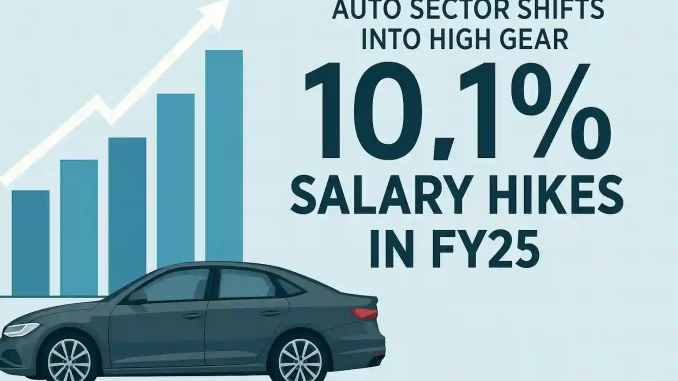
India’s automobile industry has hit the accelerator on employee compensation, awarding an average 10.1% salary hike across the sector in FY25—a significant leap compared to the modest 6–7% range seen in previous years. This robust growth in pay marks a clear indicator of the sector’s recovery and renewed confidence after years of disruption caused by the pandemic, global chip shortages, and supply-chain crises.
The hikes—announced across OEMs (Original Equipment Manufacturers), component makers, EV startups, and dealer networks—reflect the auto sector’s resurgence as a major growth engine of the Indian economy, powered by booming vehicle demand, aggressive digitization, and an all-out shift toward electrification and sustainability.
What’s Driving the Salary Surge?
Multiple structural and market dynamics are fueling this upward trend in compensation across the automotive value chain:
1. Volume Recovery and Revenue Growth
Auto sales across segments—especially passenger vehicles and two-wheelers—have surged over the past 12–18 months. FY24 saw record-breaking volumes in SUVs, premium bikes, and electric vehicles, leading to stronger balance sheets and higher operating margins for top automakers.
According to data from the Society of Indian Automobile Manufacturers (SIAM), the Indian auto industry grew by over 13% YoY in FY24, and early FY25 numbers suggest continued strength.
2. Talent War in the EV and Software Space
As auto companies race to build EV and connected mobility ecosystems, the demand for engineers in embedded systems, battery management, software, IoT, and AI has skyrocketed.
Startups like Ather Energy and Ola Electric, along with legacy players like Tata Motors and Mahindra, are offering double-digit hikes—and in some cases 20–30% premiums—to attract and retain talent in key technical domains.
“Automotive companies are transforming into tech-driven mobility enterprises,” said Divya Rajan, a talent strategy consultant at Aon India. “The fight for digital talent is real, and it’s reshaping traditional pay bands in this industry.”
3. Retention and Succession Planning
Amid high attrition in 2023 and early 2024, auto firms are doubling down on mid- and senior-level retention. Many are offering retention bonuses, performance-linked variable pay, and skill-based allowances on top of base salary hikes.
Companies are also investing in succession planning, grooming internal talent for leadership roles in EV product lines, overseas expansion teams, and sustainability divisions.
Segment-Wise Breakdown: Who Got What
According to data from HR firms like Mercer, Korn Ferry, and Aon, here’s how salary increments played out across sub-segments in the auto industry:
| Segment | Avg. Hike FY25 | Notes |
|---|---|---|
| OEMs (Cars, Bikes) | 9.5% | Higher at senior tech roles, especially in EV and R&D |
| Auto Component Suppliers | 8.2% | Operational excellence roles saw moderate increases |
| EV Startups | 12.5% | Tech, product, and energy storage talent in high demand |
| Dealerships | 7.4% | Sales & CRM roles saw variable pay spikes |
| Digital/Tech Mobility | 13.1% | Engineers, data scientists, UI/UX roles saw highest hikes |
OEMs Lead with Strategic Compensation Moves
Top automakers have publicly disclosed salary increases and are shifting from flat hikes to performance-driven compensation models:
- Tata Motors announced a 9–12% hike for mid-level tech employees, with additional bonuses linked to EV program milestones.
- Maruti Suzuki introduced a flexible benefits package and skills-based pay revisions in its R&D center in Rohtak.
- Mahindra & Mahindra rolled out “Future Skill Premiums” for employees working on e-mobility, autonomous vehicles, and AI-assisted diagnostics.
Workforce Expansion on the Cards
Beyond pay hikes, hiring momentum is building again after a period of consolidation. The top 10 auto companies in India are expected to create over 55,000 new jobs in FY25, mostly in areas such as:
- Battery engineering and thermal management
- Digital mobility solutions
- Manufacturing automation and robotics
- EV charging and infrastructure design
- Customer experience and telematics
A recent LinkedIn Workforce Report showed the automobile and mobility sector as one of the top 5 job creators in India for Q1 FY25.
Blue-Collar Workforce Also Benefits
Interestingly, wage hikes were not limited to white-collar professionals. Contractual workers and shop-floor technicians also received average wage increases ranging between 6% and 8%, depending on region and union negotiations.
OEMs like Hyundai and TVS Motor reported better-than-expected production volumes, which led to increased variable incentives and attendance-linked bonuses for factory workers.
This signals a broader trend of equitable pay distribution and a shift toward formalizing and rewarding India’s vast blue-collar workforce.
Challenges Ahead: Sustainability of Wage Growth
While the salary hikes indicate positive momentum, some experts urge caution. The auto sector still faces risks such as:
- Commodity price volatility
- EV input cost pressures (batteries, rare earths)
- Slowing global exports
- Policy uncertainty in FAME subsidy transitions
“Salary inflation must be balanced against profitability,” warned Vikram Mehta, auto analyst at Motilal Oswal. “Some EV startups are over-leveraging on talent. Without strong business fundamentals, such aggressive compensation can backfire.”
Outlook: Driving Toward a Competitive, Skilled Future
As India accelerates toward becoming a global automotive hub—especially for electric and connected vehicles—the sector’s investment in human capital is both strategic and timely.
The 10.1% average hike in FY25 is more than just a number. It’s a vote of confidence in the sector’s resilience, a signal of transformation, and a necessary step toward preparing the workforce for a cleaner, smarter mobility future.
Leave a Reply